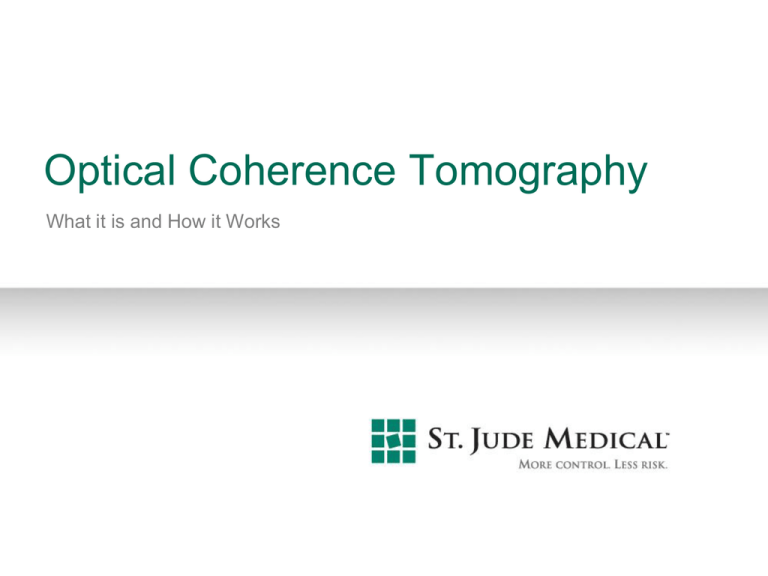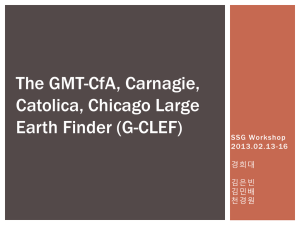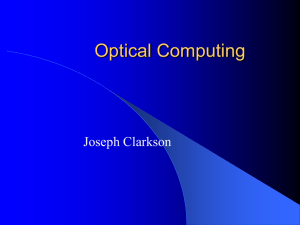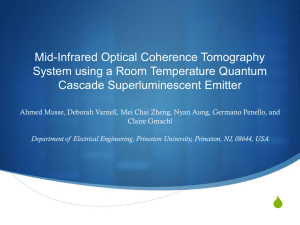
Optical Coherence Tomography
What it is and How it Works
What is Intravascular OCT?
An optical imaging modality that uses near-infrared light
for high-resolution imaging of vessel anatomy, tissue
microstructure and stents.
Key Features:
Uses light, not sound
Does not use X-ray
Image acquisition is fast
Images acquired are
sharp, detailed and easy
to interpret
Images: Drs. Grube, Buellesfeld, Guerkens and Mueller,
Helios Heart Center, Siegburg, Germany
Image: Image: Gonzalo N. Optical Coherence Tomography for
the Assessment of Coronary Atherosclerosis and Vessel
Response After Stent Implantation (Thesis) 2010
2
OCT Technology from St. Jude Medical
Console
Rapid exchange (Rx) imaging catheter
Contrast flush; balloon occlusion not required
Fast image acquisition: 5 cm pullback in 2.5 sec
3
Image Display
Cross-sectional
View
Longitudinal
View
4
Dragonfly™ Imaging Catheter
Optical fiber core
2.7 F x 135 cm usable length
Rapid exchange
Fits 0.014" guidewire
Used with 6-7 F guide catheter
Radiopaque markers
5
Pullback
length:
5 cm
Lens
Markers
20 mm apart
How Does OCT Work?
Optical fiber inside catheter spins around to create a radar-style image
6
Image Generation – Pullback
As the fiber pulls back to map a vessel segment,
a 5 cm long spiral scan is created
One pullback = approximately 270 frames
7
Image Generation
Light emitted by the
optical fiber is reflected
back by different types
of tissue
The system measures
the time delay of the
reflected light waves
An OCT image is
generated showing
vessel anatomy and
tissue microstructure
catheter
optical fiber
guidewire shadow
Gonzalo N. Optical Coherence Tomography for the
Assessment of Coronary Atherosclerosis and Vessel
Response After Stent Implantation (Thesis) 2010
8
Physics of OCT
Interference of Light Waves
Constructive Interference
Destructive Interference
9
Time vs. Frequency Domain Intravascular OCT
Time Domain OCT (TD-OCT):
Commercially available for cardiovascular
use 2001-present
Moderate image quality
Slow imaging
Requires occlusion balloon
M3 system: TD-OCT
20 fps, 1 mm/s pullback
Frequency Domain OCT (FD-OCT):
Commercially available for cardiovascular
use 2010- present
Exceptional image quality
Fast imaging: 10-100x increase in speed
Rapid contrast flush instead of balloon
occlusion
10
Gonzalo N. Optical Coherence Tomography for the Assessment of
Coronary Atherosclerosis and Vessel Response After Stent Implantation
(Thesis) 2010
C7-XR system: FD-OCT
100 fps, 20 mm/s pullback
Frequency Domain OCT
Multiple terms are used to describe the same type of OCT imaging, but
there is no fundamental difference between these methods.
St. Jude Medical:
Frequency Domain OCT
FD-OCT
Optical Frequency
Domain Imaging
OFDI
Volcano:
High Definition OCT
HD-OCT
Others:
Swept Source OCT
SS-OCT
Fourier Domain OCT
FD-OCT
Terumo, MGH:
11
Gonzalo N. Optical Coherence Tomography for the Assessment of
Coronary Atherosclerosis and Vessel Response After Stent Implantation
(Thesis) 2010
What Determines System Performance? (1/3)
Parameter
Determines
Controlled By
C7-XR Value
Imaging
Speed
Acquisition time
Required flush volume
Laser sweep rate
Catheter rotation
rate
Pullback speed
50,000 axial lines/s
100 Hz
20 mm/s
Sensitivity
Minimum detectable
tissue reflection
Image contrast
Electrical and optical
system design
Better than 100 db
Imaging
Range
Maximum vessel
diameter
Laser line width
Electrical and optical
system design
10 mm (in contrast)
Resolution
Minimum detectable
tissue feature
Speckle size and
image granularity
Laser tuning range
(axial)
Catheter focusing
optics (lateral)
15 µm (axial)
Visible depth into
vessel wall
Scattering and
absorption of tissue
1 – 2 mm
Tissue
Penetration
12
Gonzalo N. Optical Coherence Tomography for the Assessment of
Coronary Atherosclerosis and Vessel Response After Stent Implantation
(Thesis) 2010
20 – 40 µm (lateral)
What Determines System Performance? (2/3)
Parameter
Determines
Controlled By
C7-XR Value
Imaging
Speed
Acquisition time
Required flush volume
Laser sweep rate
Catheter rotation
rate
Pullback speed
50,000 axial lines/s
100 Hz
20 mm/s
Sensitivity
Minimum detectable
tissue reflection
Image contrast
Electrical and optical
system design
Better than 100 dB
Imaging
Range
Maximum vessel
diameter
Laser line width
Electrical and optical
system design
10 mm (in contrast)
Resolution
Minimum detectable
tissue feature
Speckle size and
image granularity
Laser tuning range
(axial)
Catheter focusing
optics (lateral)
15 µm (axial)
Visible depth into
vessel wall
Scattering and
absorption of tissue
1 – 2 mm
Tissue
Penetration
13
Gonzalo N. Optical Coherence Tomography for the Assessment of
Coronary Atherosclerosis and Vessel Response After Stent Implantation
(Thesis) 2010
20 – 40 µm (lateral)
What Determines System Performance? (3/3)
Parameter
Determines
Controlled By
C7-XR Value
Imaging
Speed
Acquisition time
Required flush volume
Laser sweep rate
Catheter rotation
rate
Pullback speed
50,000 axial lines/s
100 Hz
20 mm/s
Sensitivity
Minimum detectable
tissue reflection
Image contrast
Electrical and optical
system design
Better than 100 dB
Imaging
Range
Maximum vessel
diameter
Laser line width
Electrical and optical
system design
10 mm (in contrast)
Resolution
Minimum detectable
tissue feature
Speckle size and
image granularity
Laser tuning range
(axial)
Catheter focusing
optics (lateral)
15 µm (axial)
Visible depth into
vessel wall
Scattering and
absorption of tissue
1 – 2 mm
Tissue
Penetration
14
Gonzalo N. Optical Coherence Tomography for the Assessment of
Coronary Atherosclerosis and Vessel Response After Stent Implantation
(Thesis) 2010
20 – 40 µm (lateral)
Performance Comparison: FD-OCT vs. TD-OCT
C7-XR
M3
M2
Axial Resolution
15 – 20 µm
15 – 20 µm
15 – 20 µm
Beam Width
20 – 40 mm
20 – 40 mm
20 – 40 mm
Frame Rate
100 frames/s
20 frames/s
15 frames/s
Pullback Speed
20 mm/s
1.5 mm/s
1 mm/s
Max. Scan Dia.
10 mm
6.8 mm
6.8 mm
1.0 - 2.0 mm
1.0 - 2.0 mm
1.0 - 2.0 mm
Lines per Frame
500
240
200
Lateral Sampling
(3 mm Artery)
19 µm
39 µm
39 µm
Tissue Penetration
15
Gonzalo N. Optical Coherence Tomography for the Assessment of
Coronary Atherosclerosis and Vessel Response After Stent Implantation
(Thesis) 2010
Performance Comparison: FD-OCT vs. IVUS
C7-XR
IVUS
Axial Resolution
15 – 20 µm
100 – 200 µm
Beam Width
20 – 40 mm
200 – 300 mm
Frame Rate
100 frames/s
30 frames/s
Pullback Speed
20 mm/s
0.5 - 1 mm/s
Max. Scan Dia.
10 mm
15 mm
1.0 - 2.0 mm
10 mm
500
256
19 µm
225 µm
Required
Not Required
Tissue Penetration
Lines per Frame
Lateral Sampling (3 mm Artery)
Blood Clearing
16
Gonzalo N. Optical Coherence Tomography for the Assessment of
Coronary Atherosclerosis and Vessel Response After Stent Implantation
(Thesis) 2010
OCT Technical Terms
Pixel: Like a photograph, each image consists of lines and pixels.
Each pixel is approximately 5x19 microns.
Line: Each frame consists of 500 rotational lines. The greater the number of lines per frame,
the finer the texture of the image.
Frame: The optical fiber spins around to form a frame.
Frame rate: Frame rate is the number of cross-sectional frames that can be acquired over a
given period of time.
Axial: Axial is the direction that is parallel to the optical beam in an OCT system.
The axial resolution of OCT is 15 µm. Each axial line consists of 1024 pixels.
Lateral: Lateral is the direction perpendicular to the optical beam in an OCT system. The lateral resolution
of the C7-XR system is 20–40 µm, depending on the distance away from the catheter.
Optical resolution: A measure of the smallest physical feature that can be detected with an imaging
system. Measured in units of millimetres (mm) or micrometers (microns, µm). One mm is equal to one
thousand µm. A piece of paper is about 90 µm thick, while a human red blood cell is about 10 µm long.
The optical resolution of OCT is approximately 15 µm axial by 20-40 µm lateral, depending on how far the
tissue is away from the center of the catheter.
Hertz: Frame rate is measured in units of Hertz (Hz).
The optical fiber rotates at 20 Hz during preview mode (= 20 frames/second), and rotates at 100 Hz
(= 100 frames/second) during high-speed pullback. The C7-XR system acquires 50,000 axial image lines
per second. This is sometimes abbreviated by saying that it is “a 50 kHz system.”
17
OCT Technology: Key Concepts to Remember
OCT uses reflected light waves to image coronary arteries
in microscopic detail.
The latest FD-OCT is faster, the images are better, and it
does not require balloon occlusion.
The latest technology from St. Jude Medical scans a 5 cm
segment of an artery in less than 3 seconds.
As a result of its resolution and speed, OCT produces
clear, easy-to-understand views of vessel morphology and
plaque composition for planning and optimizing treatment.
18
Gonzalo N. Optical Coherence Tomography for the Assessment of
Coronary Atherosclerosis and Vessel Response After Stent Implantation
(Thesis) 2010
RX Only
Please review the Instructions for Use prior to using these devices for a
complete listing of indications, contraindications, warnings, precautions,
potential adverse events, and directions for use.
Product referenced is approved for CE Mark.
Unless otherwise noted, ™ indicates a registered or unregistered trademark or
service mark owned by, or licensed to, St. Jude Medical, Inc. or one of its
subsidiaries. GOLDEN IMAGE, the color Gold, Dragonfly, ST. JUDE MEDICAL ,
the nine-squares symbol and MORE CONTROL. LESS RISK. are registered
and unregistered trademarks and service marks of St. Jude Medical, Inc. and its
related companies. ©2010 St. Jude Medical, Inc. All rights reserved.
19







